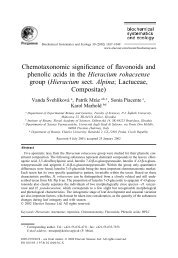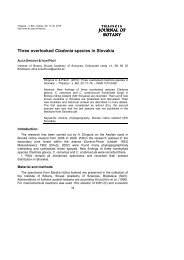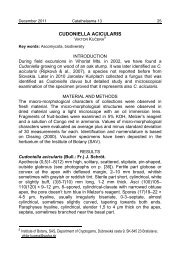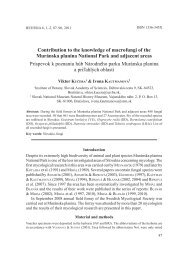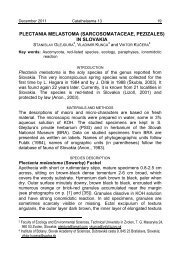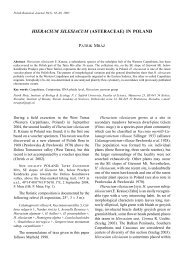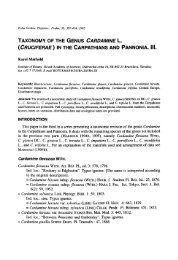Typification of the Linnaean names of the genus - institute of botany ...
Typification of the Linnaean names of the genus - institute of botany ...
Typification of the Linnaean names of the genus - institute of botany ...
You also want an ePaper? Increase the reach of your titles
YUMPU automatically turns print PDFs into web optimized ePapers that Google loves.
LINNAEAN NAMES OF THE GENUS CARDAMINE<br />
104, 118). The latter specimen corresponds well to <strong>the</strong> current use <strong>of</strong> <strong>the</strong> name, and<br />
J.L. Reveal, College Park, on <strong>the</strong> label attached to this specimen, suggested it should<br />
be <strong>the</strong> lectotype <strong>of</strong> <strong>the</strong> name Cardamine virginica.<br />
The last item in <strong>the</strong> protologue which should be considered is <strong>the</strong> illustration in<br />
Plukenet’s Phytographia (1691: tab. 101). The plant depicted roughly corresponds to<br />
<strong>the</strong> current use <strong>of</strong> <strong>the</strong> name.<br />
After consideration <strong>of</strong> all elements from <strong>the</strong> protologue and following <strong>the</strong><br />
suggestion <strong>of</strong> Reveal (pers. comm.) <strong>the</strong> specimen from Clayton’s herbarium in<br />
London (BM, no. 462) is designated here as <strong>the</strong> lectotype <strong>of</strong> <strong>the</strong> name Cardamine<br />
virginica L.<br />
ACKNOWLEDGEMENTS<br />
The author is very grateful to Gina Douglas, Librarian <strong>of</strong> <strong>the</strong> Linnean Society <strong>of</strong><br />
London, for invaluable help with <strong>the</strong> literature, and to Charles E. Jarvis and Nick<br />
Turland, <strong>Linnaean</strong> Plant Names <strong>Typification</strong> Project, Department <strong>of</strong> Botany,<br />
Natural History Museum, London, for patient and helpful discussion <strong>of</strong> <strong>the</strong> drafts <strong>of</strong><br />
<strong>the</strong> manuscript. Thanks go to <strong>the</strong> curators <strong>of</strong> herbaria BAS, BM, BOLO, GE, IBF,<br />
L, LINN, LY, OXF, P, S, and W for <strong>the</strong>ir help with <strong>the</strong> herbarium specimens and<br />
to <strong>the</strong> Library <strong>of</strong> <strong>the</strong> Department <strong>of</strong> Plant Sciences <strong>of</strong> <strong>the</strong> University <strong>of</strong> Oxford for<br />
enabling access to <strong>the</strong> Sherard manuscripts. This work was supported by <strong>the</strong><br />
Ministry for Sciences and Research, Vienna, Austria through <strong>the</strong> East-West<br />
Programme <strong>of</strong> <strong>the</strong> Austrian Academy <strong>of</strong> Sciences (Project no. OWP 58), by <strong>the</strong><br />
Grant Agency for Science, Bratislava, Slovakia (Grant. no. 2/2032), and by <strong>the</strong><br />
Leverhulme Trust (Fellowship at <strong>the</strong> Department <strong>of</strong> Botany, University <strong>of</strong> Reading,<br />
U.K.), which is gratefully acknowledged.<br />
REFERENCES<br />
Alston AHG. 1957. A <strong>Linnaean</strong> herbarium in Paris. Proceedings <strong>of</strong> <strong>the</strong> Linnean Society <strong>of</strong> London 168: 102–103.<br />
Barrelier J. 1714a. Plantae per Galliam, Hispaniam et Italiam observatae. Paris.<br />
Barrelier J. 1714b. Icones plantarum per Galliam, Hispaniam et Italiam observatae. Paris.<br />
Bauhin C. 1620. Prodromus <strong>the</strong>atri botanici. ed. 1. Frankfurt.<br />
Bauhin C. 1623. Pinax <strong>the</strong>atri botanici. ed. 1. Basel.<br />
Bauhin C. 1671. Pinax <strong>the</strong>atri botanici. ed. 2. Basel.<br />
Bauhin J, Cherler JH, Chabrey D. 1651. Historia plantarum universalis. 2. Yverdon.<br />
Boccone P. 1674. Icones et descriptiones rariourum plantarum Siciliae, Melitae, Galiae et Italiae. Oxford.<br />
Boccone P. 1697. Museo di piante rare della Sicilia, Malta, Corsica, Italia, Piemonte, e Germania. Venezia.<br />
Botschantzev VP. 1972. O Parrya R. Br., Neuroloma Andrz. i nekotorykh drugikh rodakh (Cruciferae). Botanicheskii<br />
Zhurnal 57: 664–673.<br />
Burman J. 1737. Thesaurus zeylanicus. Amsterdam.<br />
Burtt BL. 1952. The <strong>genus</strong> Ricotia. Kew Bulletin 1951: 123–132.<br />
Busch NA. 1939. Rod 591 Serdechnik — Cardamine L. In: Komarov VL, ed. Flora SSSR (Flora URSS). 8: 153–170.<br />
Moskva & Leningrad: Izdatel’stvo Akademii nauk SSSR.<br />
Camerarius J. 1586. De plantis epitome utilissima Petri Andreae Matthioli. Frankfurt.<br />
Camerarius J. 1588. Hortus medicus et philosophicus. Frankfurt.<br />
Candolle AP de. 1821. Regni vegetabilis systema naturale. 2. Paris.<br />
Clokie HN. 1964. An account <strong>of</strong> <strong>the</strong> herbaria <strong>of</strong> <strong>the</strong> Department <strong>of</strong> Botany in <strong>the</strong> University <strong>of</strong> Oxford. Oxford: Oxford<br />
University Press.<br />
Clusius C. 1583. Rariorum aliquot stirpium, per Pannoniam, Austriam, et vicinas quasdam provincias observatarum historia.<br />
Antwerpen.<br />
Clusius C. 1601. Rariorum plantarum historia. Antwerpen.<br />
Czerepanov SK. 1981. Sosudistye rastenija SSSR (Plantae vasculares URSS). Leningrad: Nauka.<br />
129



